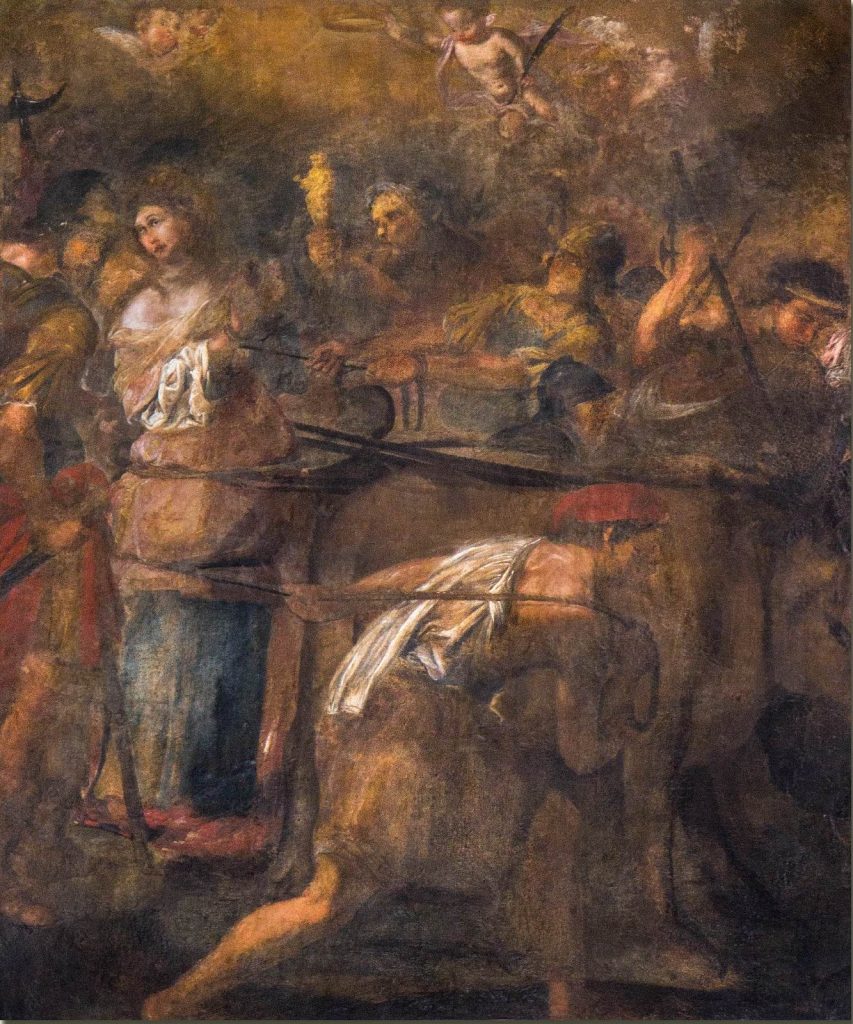Saint Lucia led to martyrdom

Author: unknown from Messina
Dating: mid-17th century
Material: oil on canvas
Size: cm 146 x 115
Provenance: Ancient Cathedral in the Fortified City
The painting depicts Saint Lucia led to martyrdom and is presented as a simultaneous and very excited narration of several moments of the hagiographic story. The saint is dragged with force by her tormentors and a pair of oxen, by means of ropes that surround her body and hands; his gaze is turned to the sky where an angel bears the symbols of martyrdom (the crown and the palm). Under her feet are placed burning embers – although not very readable – that allude to the torment of fire to which she was subjected.
Around Lucia is crowded the group of torturers. Some are busy pulling the ropes with every effort to move the body made miraculously heavy. In fact the hagiographic sources (the Passio and the Acts of the martyrs, both dating back to the fifth century ) tell that the young woman from Syracuse – lived in the fourth century, during the great persecution ordered by the emperor Diocletian -, was denounced by the promised pagan husband rejected and submitted to a trial celebrated by the proconsul Paschasius, who, In the face of the firmness and pride of the maiden, he determined that she should be taken to a brothel. After the vain sentence, every effort was made, even with the intervention of oxen, to move the body that had become very heavy. One of the figures in the painting is showing off a gold statuette, referring to the proposal made by the proconsul to deny the Christian faith and worship pagan idols. On the far left a soldier is depicted drawing his sword, which was driven into her throat and killed her. The work is characterized by an intense dramatic tone that invades all figures through the wise use of light that radiates from above, from the left corner.
The painting is similar to the large altarpiece of equal content made in the second half of the sixteenth century by Deodato Guinaccia for the church of the Monastery of Santa Lucia di Siracusa. The narrative intent and emotional charge that moves the scene are similar, for which the figures act in a dramatic manner, although the Syracusan opera is more choral, while the Milazzese presents a more restrained breath. The unknown author of the canvas here present seems to give evidence of knowing the work of Guinaccia, especially in the pose of the saint and the soldier who, On his left, he holds a rope with both hands that reminds him of a male figure in the same operation in the Syracusan painting.
According to Chillemi, the work comes from the old cathedral. According to the scholar it was placed on the first altar on the left.
The conditions of the framework do not allow a clear reading. It was in fact subjected to an unspecified time to a careless restoration that attacked the pictorial part removing some layers; it is possible that on the same occasion the canvas has undergone a scaling on all four sides. This is clearly indicated by some inexplicably cut elements, such as the head of the oxen on the right, of which a part is missing or, at the top, the scene of the little angels with part of their head missing. (but also the foot of the Aguzzino at the bottom and the soldier on the left also cut in half). Nor has the recent restoration been able to restore the original state or repair the damage.
As regards the dating, from the few elements still readable one could assume a realization dating back to the middle of the seventeenth century or the first decades of the second half; it is also difficult to formulate a thesis on the author, which seems to be within the regional scope.